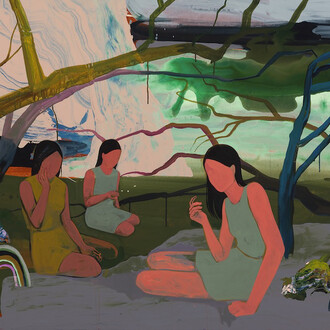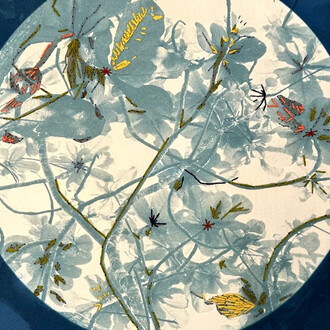On September 12, Venus Over Manhattan will open the first US-based solo exhibition of artist and poet John Pule. From the small island nation of Niue in the South Pacific Ocean, Pule has risen to become one of the region’s most celebrated and important artists and is increasingly gaining notoriety across the world. His intricate paintings and drawings offer distinct meditations on the history, natural environs, and iconography of his home island and Polynesia more broadly. With John Pule, Venus Over Manhattan presents a unique opportunity for American audiences to experience the depth of Pule’s dynamic work, enhancing global awareness of his singular vision and practice.
“We look forward to presenting the first solo exhibition of John Pule’s work in New York, and in the U.S. more broadly. As representation of and dialogues with Indigenous artists have increased over the past few years, we are excited to bring more global Indigenous voices into the conversation”, said Adam Lindemann, founder of Venus Over Manhattan. “John’s work is truly unique, both formally and conceptually, and will have strong relevance and resonance for many people. It’s our pleasure to further enhance knowledge of and engagement with his important practice”.
To further explore Pule’s dynamic work and especially his recent paintings featured in the forthcoming exhibition, Venus Over Manhattan will host a panel discussion with the artist and Dr. Maia Nuku, Curator for the Arts of Oceania at the Metropolitan Museum of Art, who has known Pule since the 1990s. More details regarding the date of the event will be shared in the coming weeks.
Pule was born in the village of Liku, immigrating to Aotearoa New Zealand at an early age. Pule remains deeply connected to his birthplace and now splits his time between Niue and Auckland. A self-taught artist, who first entered creative spheres through his extensive and award-winning body of poetry, Pule often draws on his own migration story and sense of identity to explore broader Niuean culture and mythologies. His art intertwines expressions of land, ocean, and people, both familiar and foreign, as well as symbols of colonization, displacement, and religion to create a visual topography that embraces personal and communal histories.
Pule’s visual vocabulary is also strongly informed by hiapo, a traditional Niuean decorative barkcloth. In the 19th century, hiapo were characterized by motifs inspired by native plant life and produced in fluid freehand directly on the cloth. With colonization, these works began to feature images of colonial influence, melding traditional Niuean cultural iconography with that of modern events. Pule’s own work often emphasizes representations of nature as well as references from across culture and time, bringing past and present together into singular compositions on canvas, barkcloth, and paper.
John Pule features new paintings from a series produced in the past year. Paintings such as Takeleaga, Hina, Haia, and Deep Niue evening showcase Pule’s distinct engagement with both rich, saturated color and evocations of nature. The vibrant paintings compel the eye and draw the viewer into Pule’s fantastical abstract landscapes. Works like These hot evenings make dreaming difficult establish an entirely different visual encounter, capturing Pule’s incredible range. In this work, and others like it, symbols and gestural marks collide in an open expanse, flattening any specific sense of time, place, and narrative, and highlighting Pule’s contemporary sensibilities as he illuminates different historical touchpoints. Works from this series recently featured prominently in the 2024 Sydney Biennale.
While the influence of hiapo appears across Pule’s oeuvre, works such as Miomimioi (2023) and Nakai momohe a tautolu, Ka e faliu a tau-toli oti (c. 1994) offer the greatest visual continuity. Here, much like in many of the traditional barkcloth works, symbols, marks, and references are presented within a loose grid, encapsulating parts of an expansive story within a contained structure. The works are both elusive and evocative, framing ongoing histories and mythologies with a compositional continuum.
Together, the works on view offer a broad view into the depth and breadth of Pule’s practice, highlighting his unique ability to bring together different narrative threads and expressions in ways that both honor cultural traditions and create an utterly contemporary experience.
Pule’s paintings were featured in a publication accompanying Dr. Nuku’s exhibition, Atea: nature and divinity in Polynesia (Nov. 2018 – Oct. 2019) at the Metropolitan Museum. In this publication, she writes that his paintings “embrace an atmosphere suggestive of ancient landscapes, a primordial Polynesia”. “Verdant and glossy”, Nuku writes, “these latest works seem to pulse with the energy of burgeoning life, from the thick undergrowth of the forest to the glassine sanctum of underwater rock pools… They speak eloquently to the flourishing life brough on by atea, the light: the brief but crucial spark, conceived as consciousness, that evolved into the layered canopies of the sky and drew the cosmos out of the darkness”.
John Pule (b.1962, Liku, Niue) is a renowned artist and poet. His work has been presented extensively at prestigious institutions and events, including at the Queensland Art Gallery, 24th Biennale of Sydney, and Asia-Pacific Triennial. In 2011, the Auckland Art Gallery held a major survey of his work, highlighting his significant contributions to contemporary art, and in 2018, one of his large-scale, multi-panel paintings was featured in the monumental survey Oceania at the Royal Academy of Arts in London. Pule has been invited to important residency programs, including at the Romerapotheke Art Residency in Basel, Switzerland, and been honored with such awards as the Laureate Award given by Arts Foundation of New Zealand. Pule’s work is held in several public collections, including the Auckland Art Gallery, Te Papa Tongarewa (Museum of New Zealand), the National Gallery of Victoria, and the Queensland Art Gallery.
Notes
1 Atea: nature and divinity in Polynesia, The Metropolitan Museum of Art Bulletin (Winter 2019), p. 47.
















